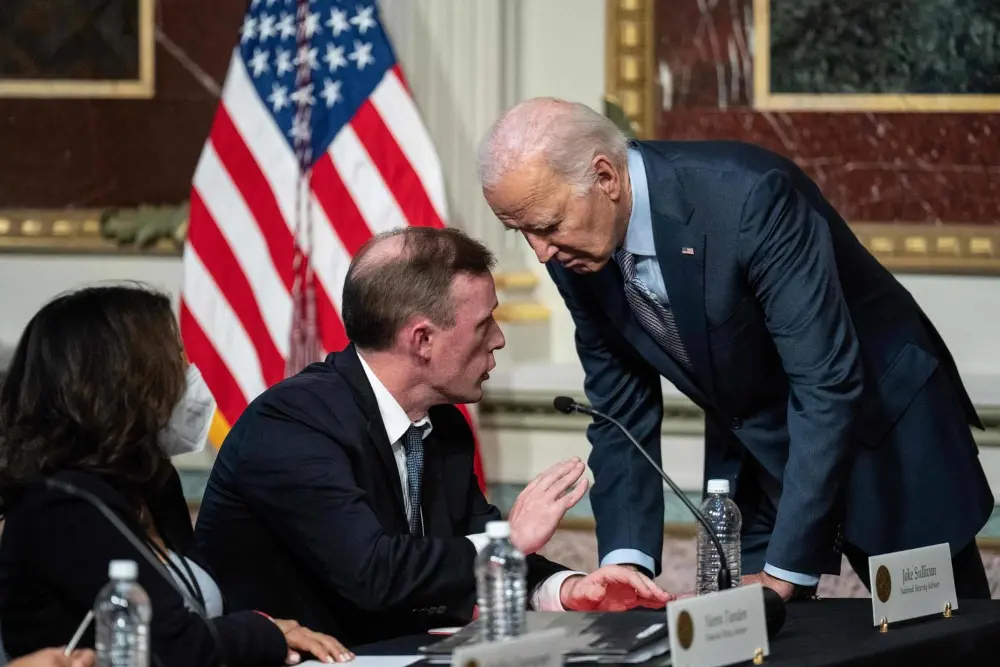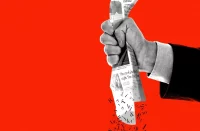Every one of this neoconservative Government’s foreign policies has failed or is failing; and an excellent example of this was shockingly provided by the New York Times on December 17th under the headline “How Putin Turned a Western Boycott Into a Bonanza: If companies want to leave Russia, the president is setting the terms — in ways that benefit his government, his elites and his war.” (Since that newspaper has low-quality managers/editors, that phrase “a Western Boycott” is false and actually should have been “Western Sanctions” — which, as even the article’s text pointed out, are importantly different, and are what is being applied to, and failing against, Russia. A “boycott” is imposed by consumers; “sanctions” are imposed by Governments.)
This example of their stupidity can be summed-up very simply, as follows: Biden, and his advisors and academic consultants, had assumed that by imposing sanctions to isolate and starve Russia’s economy, there would be a huge weakening of Russia’s economy so that in the short term Russia’s war-effort in Ukraine would become starved of funds, and in the long term Russia’s GDP at Purchasing-Power-Parity, the Russian economy itself, would shrink while America’s would become even more attractive for international investors than it already was. However, instead, Russia’s Government, which possesses the legal right as a sovereign nation to set the terms upon which foreign corporations would be allowed to exit their Russian operations (that being a primary purpose of the Biden Administration’s economic sanctions against Russia), made these decisions strategically, so as to require that those foreign assets of exiting firms that are in Russia must be discounted at least 50% to Russian purchasers, and that ONLY Russian investors who are paid-up on their taxes and have been of benefit to Russia’s economy (these buyers were propagandistically called by the NYT “Putin’s elites”) will qualify as prospective purchasers of those formerly foreign-owned assets.
Consequently, Putin, who has a track-record of making predictions that are honest and therefore almost always come true, as opposed to what is the norm in U.S.-and-allied Governments (where lies are routine, and the predictions are consequently almost always far rosier than the actual results turn out to be), said the following on December 14th at his “Results of the Year with Vladimir Putin” press conference, when he spoke about the performance of Russia’s economy:
You know, I have brought a chart with me, as I usually do. There is nothing we do not know, and I believe the Finance Minister spoke about some figures yesterday. The main indicator of economic growth is GDP, which is expected to have grown by 3.5 percent as of the end of the year. It is a good indicator, which shows that we have recouped last year’s losses (when GDP decreased by 2.1 percent). If it grows by 3.5 percent this year, it means we have recouped the losses and have taken a significant step forward.
Unfortunately, inflation has increased and is expected to reach 7.5 percent as of the end of the year or slightly higher, around 8 percent. But the Central Bank and the Government are taking the necessary action. We can talk more about this, I mean raising the key interest rate and other measures being taken by the Central Bank and the Government. Our expectation is that we will be able to return to our target indicators.
Our industrial output is increasing steadily, at 3.6 percent. I am particularly pleased with the results in manufacturing, where output has grown by 7.5 percent year-on-year. It is a result we have not seen in a long time.

It is especially uplifting to see that investment in fixed capital has risen by 10 percent. What does this mean? The growth in industrial output and GDP are obvious. Plus 10 percent in fixed capital investment, what does it indicate? It indicates there will be sustainable growth in the medium term. Investors provide funding; production will expand; and new jobs will be created. I will talk about the unemployment rate later.
Businesses have added 24 percent in profit, not to mention the banks, which will earn almost three trillion rubles, in fact, over three trillion rubles by the end of the year. Of course, I know that people in the audience and generally across the country will say: banks are rolling in clover and so on. It is true. But it is good news for people who keep their money in Russian banks because it signifies the resilience of the banking system.
Now, real wages will grow by around eight percent after inflation. I understand that it will not be true for everybody but on average across the country, this statistic is accurate. And real disposable income is already on the rise. This indicator depends on more factors so the increase will be around five percent.
I mentioned the unemployment rate. Only recently, we were proud to see it drop to a historic low of three percent. Yesterday, when my colleagues and I were preparing for today’s meeting, we noted that the unemployment rate is now 2.9 percent. It is something we have never seen in Russian history. It is a very good integrated indicator of the economy’s health.
Since I talked about the rise in real income, I should mention that the minimum wage will be increased by as much as 18 percent from January 1. We do not do this very often.
The foreign debt is decreasing. This also indicates macroeconomic stability, financial stability. Government debt has been reduced from US$46 billion to US$32 billion. And private foreign debt has also decreased (our companies are duly repaying all the loans taken from foreign financial institutions) from US$337 billion to US$297 billion. That is, repayment is proceeding at a steady pace, often even ahead of schedule.
And this is an integrated social indicator. We will probably have a lot of social issues to discuss today, but still, there is such an integrated indicator – the growth in life expectancy, something we always talk about and strive for.
Look at the dynamics: in 2021, life expectancy in Russia was 70.06, in 2022 it was 72.73, and in 2023 it is expected to be 74 years. Still, this is a measure of how the state’s efforts in both the economy and social policy are reflected in the most important social indicator.
Here is the track-record of the world’s major economies (including U.S., EU, Japan, South Korea, India, China, and Russia) according to the IMF and World Bank, and based upon not merely GDP but instead GDP at Purchasing-Power-Parity, which far more accurately reflects what things are like for the residents in the given country:
On 14 November 2023, I headlined “America and its allies are CLEARLY declining powers”, and documented that in terms of Gross Domestic Product at Purchasing Power Parity, the world during 1990 to 2022 rose 5.58 times, Russia rose 5.33 times, the U.S. rose 4.24 times, the EU rose 3.90 times, and China rose 21.83 times. The reason for Russia’s sub-par performance during that period was that in the 1990s (the period’s first ten years) the U.S. controlled Russia, and Harvard’s economics Department was brought in to ‘advise’ Yeltsin’s Government on how to convert to a capitalist economy by cutting America’s billionaires in on and making ‘partners’ of Russians that they and Yeltsin’s people would select to skim Russia’s economy, so that Russia’s economy crashed during those years. Putin came into power when Yeltsin quit on the first day of the new Millennium, he took control away from the billionaires and their U.S. partners, and Russia’s economy started taking off like a rocket within three years and has kept doing so ever since — benefitting the Russian people enormously.
On 6 December 2023, I headlined what would have come as shocking news to my fellow Americans if the U.S.-and-allied ‘news’-media hadn’t been hiding it all along, “America: A record of Economic Failure for the Past 25 Years”, and documented that between the first day of 1998 and the last day of 2022 (this 25-year period during which Putin has been in power):
China’s economy grew 6.4 times (“x6.4”) over those 25 years, Russia’s grew 5.9 times over those 25 years, India’s grew 2.96 times over those 25 years, U.S.’s grew 1.36 times over those 25 years, EU’s grew 1.40 times during those 25 years, Japan’s grew 1.17 times over those 25 years, and South Korea’s grew 2.37 times over those 25 years.
Here is the performance of the entire world over those 25 years:
https://tradingeconomics.com/world/gdp-per-capita-ppp-us-dollar-wb-data.html 25-yr=22/7=x3.14
So: x3.14 is the global average performance over the most-recent 25-year period..
In other words: whereas India performed slightly worse than the global average, the U.S., EU, Japan, and South Korea, performed considerably worse than the global average during those 25 years.
So, while Putin has been in power in Russia (2000-2022), its economy has been performing almost as well as China’s. The U.S. regime and its allies want to get rid of Putin and of Xi because Russia and China under the present leadership have soared way past the U.S. and its colonies (‘allies’) — and the leaders of the U.S. and its allies want to do to Russia and to China what they already have done to Iraq, Syria, Ukraine, and Libya, and what they’ve been trying to do to Iran and Venezuela: take them over and destroy them for the benefit of U.S.-and-allied billionaires. (After all: war is profitable for billionaires.) In short: Putin and Xi have gotten in the way of what U.S.-and-allied billionaires want.
As neocons, U.S.-and-allied political leaders believe only in win-lose games and therefore are constantly trying to conquer (either via coups or via military invasions) economic competitors. Win-win games don’t appeal to them. However, whereas win-win games produce improvement for both sides, win-lose games produce lots of losses in friction, and therefore neocons are bad for any nation’s economy. Unfortunately, it has become The American Way.














Comments